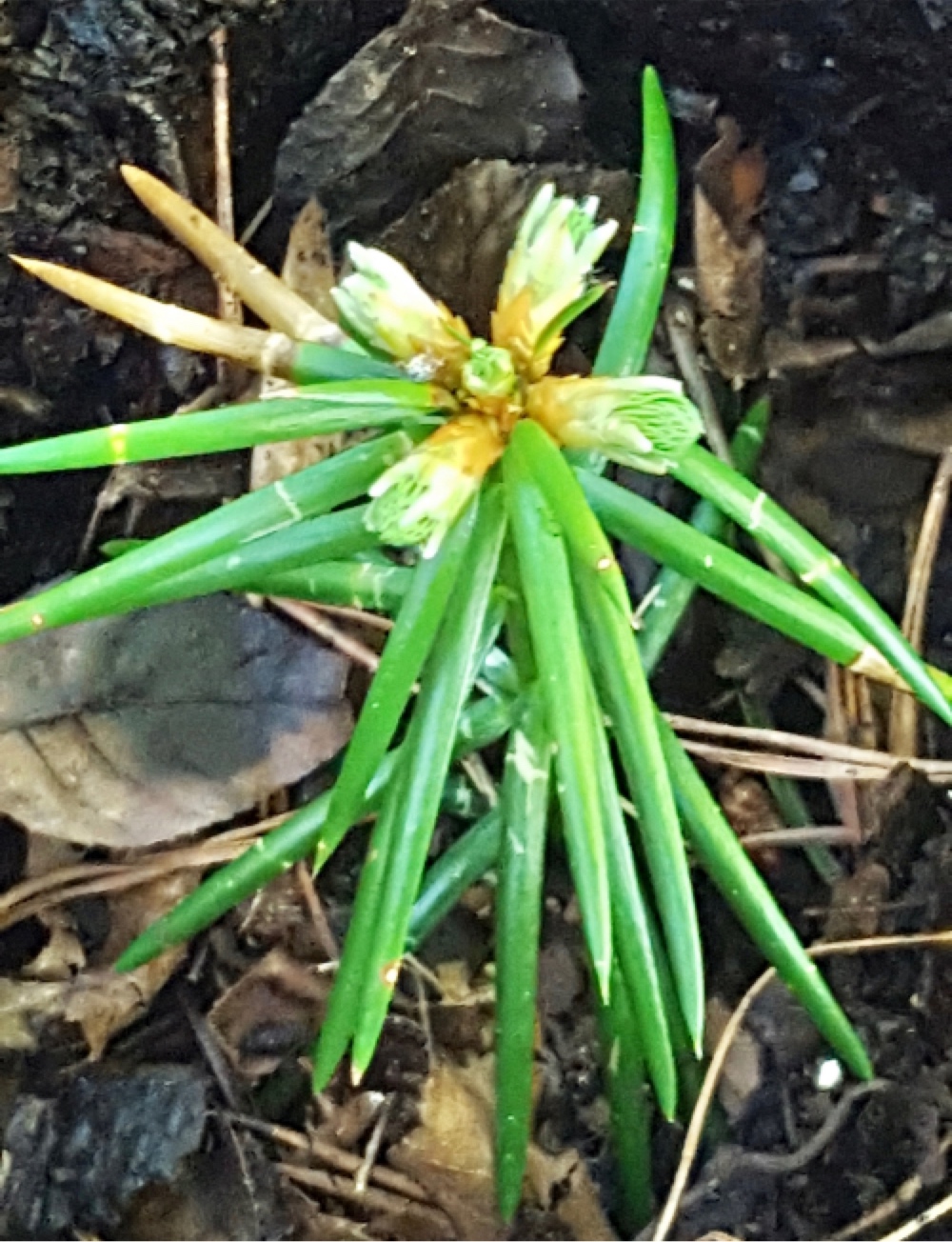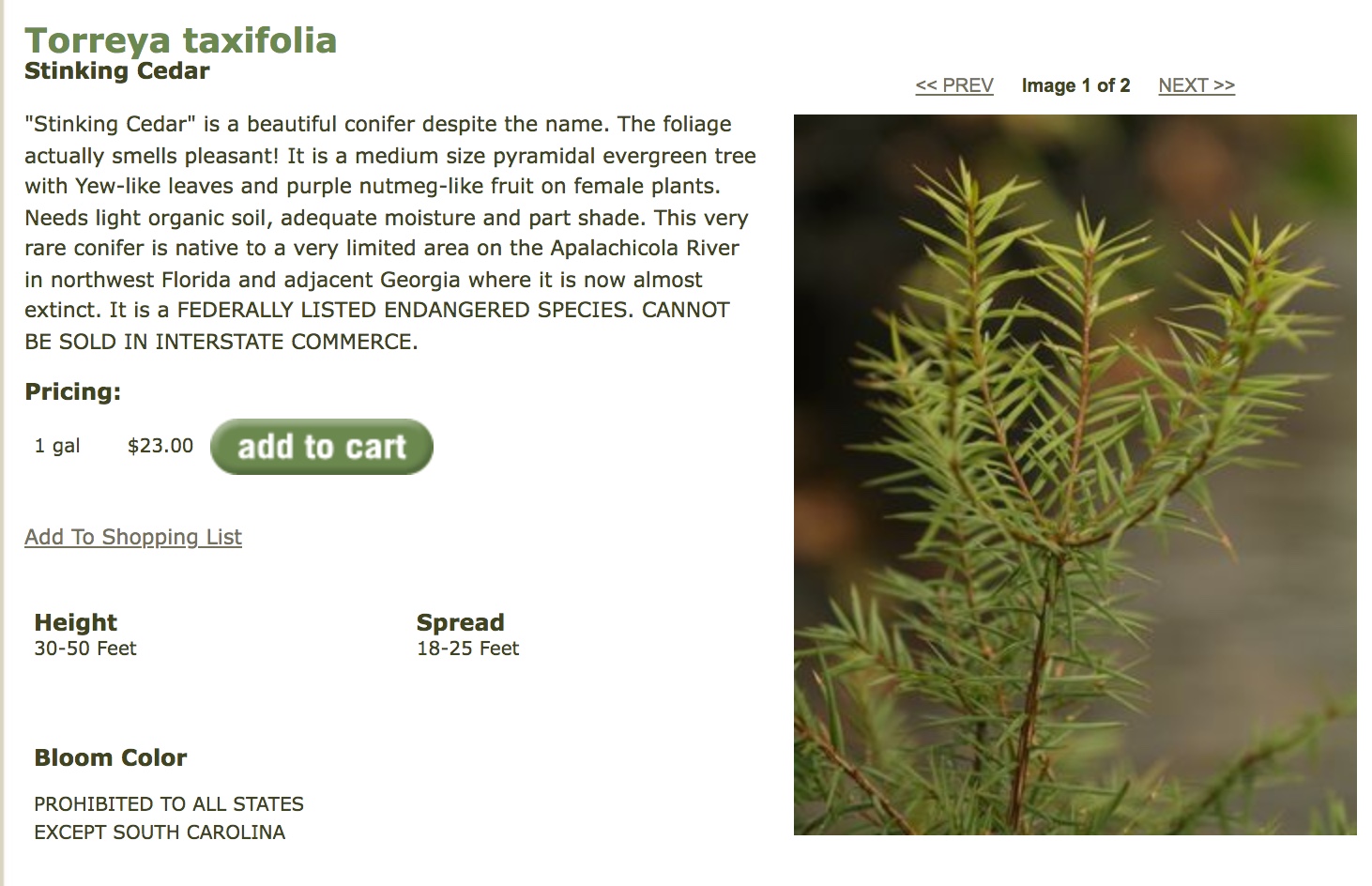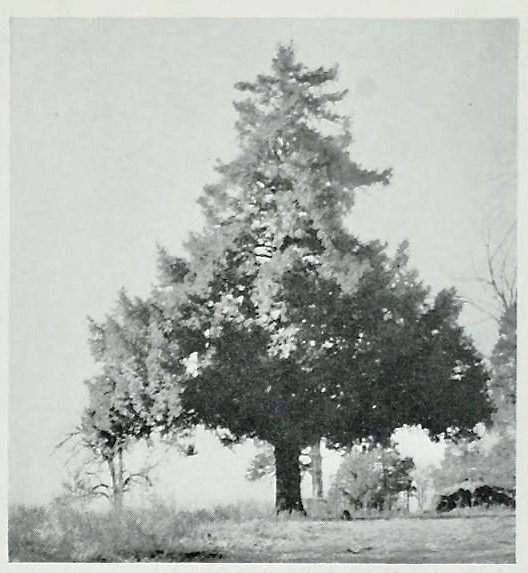  |
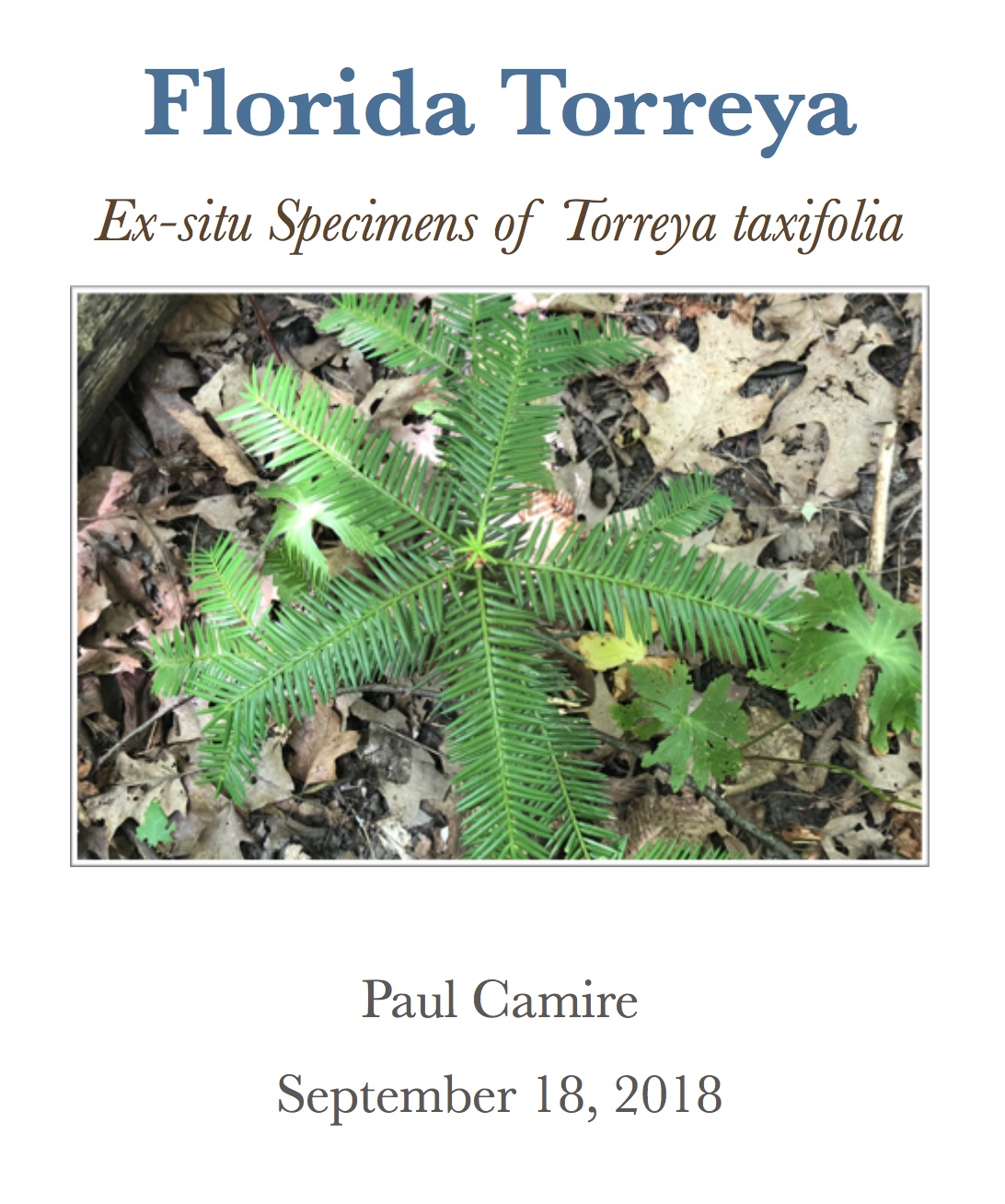 PAUL CAMIRE, Torreya Guardian in southern Michigan, has pored through internet archives in quest of a complete list of horticultural plantings of Florida Torreya. The above document in pdf is 24 pages. LEFT: Paul also has scouted for archival photos — including this undated photo of the NORLINA TREE, which appeared in the 1951 book by Elvenia Slosson, Pioneer American Gardening. Here the story piques our interest. The caption reads, " ... it is said to have been a 'hospitality gift' from President Buchanan." James Buchanan was USA President 1857-1861. |
Torreya Guardians are especially keen on documenting specimens planted well north of Torreya's small glacial refuge in northern Florida. As well, Paul Camire attempts to discover which of the early plantings still exist, their health, and the extent to which their genetics may still be represented in living descendants or clonal cuttings.
Whenever a road trip presents a chance to visit such a site, Paul finds time to make it happen. December 2021, he visited the Norlina Tree and spoke with the long-time owner, CALVIN SEAMAN.
can be found at the end of this chronological list of photos and investigations.
Archival Photos and Documentation
chronological
PAUL CAMIRE wrote, August 2020 and January 2022:
• 1984 DOCUMENTATION of the Norlina Tree:
"I've been to the Norlina Torreyas in mid-1980's. There was a very large torreya (notably a Champion so must be other records on girth/height/etc.) and many smaller trees that appeared to have been transplanted/moved around the landscape.
• The 1986 recovery plan for Torreya taxifolia (its first) contains this mention of the Norlina tree:
• 2006 Robert Zahner: In an email to Connie Barlow July 2006, Zahner wrote,
I have a photo of this tree taken in 1939, and even then (67 years ago) it was over two feet in diameter, a beautiful tree."
ROBERT ZAHNER (1923-2007), Professor of Forest Ecology, Clemson University
__________
• 2009 DOCUMENTATION of the Norlina Tree:
In Bullard's comment, he also mentioned the Norlina Tree.
The editor of North Carolina Wildlife then reported in the next issue:
"This tree was one of the two that were planted in Clinton NC in the 1850s, around the same time that it is estimated the state champion tree in Norlina was planted. A storm in the late 1990s knocked down one of the Clinton Torreyas, but the other survives today. Bullard also explained that the researchers had traced the Norlina and Clinton trees to a single source. Pomaria Nurseries, an antebellum outfit near Columbia, SC, sold a tremendous variety of native and exotic fruit trees, ornamental trees, shrubs and flowers during that era. Scientists made the connection because Osage orange trees were planted near both Torreya sites, and Pomaria sold both types of trees.
"Bullard and his late cousin, Bob Melvin, verified the identity of the Clinton trees in 1995 and collected 5,000 seeds from the trees, which they distributed to botanists across the state for attempted propagation. Seeds were planted at sites from Meredith College in Raleigh to Western Carolina University in Cullowhee. Perhaps the most surprising fact Bullard provided was that, contrary to botany textbooks, Torreya is not dioecious — that is, having male and female reproductive structures on separate plants. Rather, it is monoecious, because both the Norlina and Clinton trees are producing viable seeds with no other Torreya around. Bullard knows this firsthand because he has two Torreya trees on his own property — both bearing fruit."
• 2017 North Carolina's Champion Big Tree Database (North Carolina Forest Service):
__________
• 2021 "INELIGIBLE" on North Carolina's Champion Big Tree Database
PAUL CAMIRE (below), planter of Torreya trees in southern Michigan, refashioned a scheduled road trip in order to visit the Norlina Torreya tree. While there, he spoke with the long-time owner, Calvin Seaman.
LEFT: Click for a 5-page illustrated STORY by Paul Camire.
BELOW: Continue reading for more DETAILS and PHOTOS drawn from Paul's initial email correspondence.
I've had hope that the tree was still alive for sometime now. It took me a few years to figure out the exact location and after I found the herbarium sheets with the photographs, I cross-referenced them against the location I suspected the tree was located. It was a match. The last Google satellite view of the farm was from 2018, and there appeared to be some bushy growth stemming from the tree.
About a year ago, I located a phone number, called, and left a message. But I didn't receive a return call. I figured I had a wrong number or possibly the owners didn't want to be bothered.
I was planning on visiting Clint Bancroft [torreya planter in eastern TN] and Jack Johnston [torreya planter in north Georgia] on my return trip. However, I decided to travel up I-95 towards home, due to the projected weather. I took a big detour to the Seaman farm, hoping I could at least see the tree.
I got a few pictures and the video, and then was looking for my tape measure when Calvin Seaman came out. Surprisingly, he remembered that I had called a year prior, and was surprised I didn't get a call back from his wife, Judith, to invite me to stop by. He was very nice to talk with and gave me lots of information.
The farm had been part of a large plantation. Around 1860, PRESIDENT BUCHANAN overnighted there while traveling to Washington from Florida. He gave the Torreya as a hospitality gift.
So, the tree is approximately 160 years old!
So what I was seeing was recovery.
There are sprouts all up the trunk.
As you look at the dead branches you will see foliage from what must be thin strips of bark on the top of the branch. (Jack and I were discussing this earlier today.)
The cow pasture is now located around the tree, but there doesn't appear to be any herbivory.
The trunk is huge and about twice the size of the Torreya tree in Madison, Florida [which Paul visited in 2018].
They are taking on a branch form.
Not many of them have vertical shoots.
I was allowed to take a few basal cuttings and am sending them to Jack and Clint.
In addition to the cuttings, I brought home a piece of bark and a small branch that had fallen from the tree. I'm going to examine them and see if I can make any additional findings. There are what appear to be woodpecker holes in the dead branches and there were rodent holes around the base of the tree. There was some cracking in the bark of the main trunk.
I wish I had a drone or a tall ladder to document the upper structure of the tree. The large, long branch was interesting to see.
"We talked about how it's believed that the ark was built from Torreya trees and several other bits of Torreya lore."
HISTORY: The tree has produced SEEDS and SEEDLINGS in the past. The last sapling remaining sprouted up next to one of the barns and someone from an Alabama college was allowed to dig it up, and it is still alive.
END OF REPORT BY PAUL CAMIRE, December 2021.
UPDATE 2022: A BASAL TIP CUTTING IS ROOTING!
UPDATE JULY 2022 (email by Paul Camire): "... I'm most excited by Clint's luck with the Norlina cuttings. I have to ask Jack again how his are doing. When I shipped them out, Clint received his right away, but Jack's got lost for almost a week somewhere. He said they still looked great when he got them, but that could be part of the reason his were a little slower on growth. I only kept two cuttings for myself, but once the buds started swelling, then they turned black and died. Clint and Jack both have a talent for Torreya!"
Nearby were placed rooted branchlets from one or both of the male trees at the Henry Foundation in Gladwyne, Pennsylvania.
Thanks to this mini orchard in South Carolina, many offspring of the Norlina + Gladwyne pairing were planted and over a wide geographic area.
LEFT: An old archival photo and a 2018 photo-essay by Paul Camire of torreya in Gladwyne, PA.
By the time Torreya Guardians formed in 2004, Woodlanders had a good supply of potted seedlings. As of 2021, Torreya taxifolia is still listed for sale (see below). Notice that because the Endangered Species Act prohibits the sale of endangered plants in interstate commerce, Torreya Guardians (such as Paul Camire) have a long drive in order to purchase potted seedlings right there in South Carolina.
ABOVE: FRED BESS in Cleveland, Ohio, is the first Torreya Guardian to produce seeds far north of Florida Torreya's peak glacial refuge. The three torreyas pictured here were purchased from Woodlanders, so they are descendants of the Norlina + Gladwyne pairing. Because Fred planted the potted seedlings in her front yard in full sun, seed production began in 2017. (Photos above by Connie Barlow, during her visit there autumn of 2018.)
In contrast, beneath a full deciduous canopy, it takes a lot longer for a young torreya to grow enough to produce seeds. Fortunately, as with other subcanopy trees (such as American Beech, Eastern Hemlock, Sugar Maple), torreya is patient. Torreya waits for a canopy opening (such as a treefall) to offer enough sunlight to encourage rapid growth and, beyond that, seed production.
LEFT: Lee Barnes holds the 1984 photo he took of the Norlina Tree in front of a just-planted Torreya seedling at the Waynesville site, July 2008.
CENTER: Sarah Evans photographed one of the 2008 plantings 13 years later. This "Maxilla" seedling was named for Sarah's mother. The sapling looks healthy, but still favoring a horizontal rather than a vertical quest for sunlight.
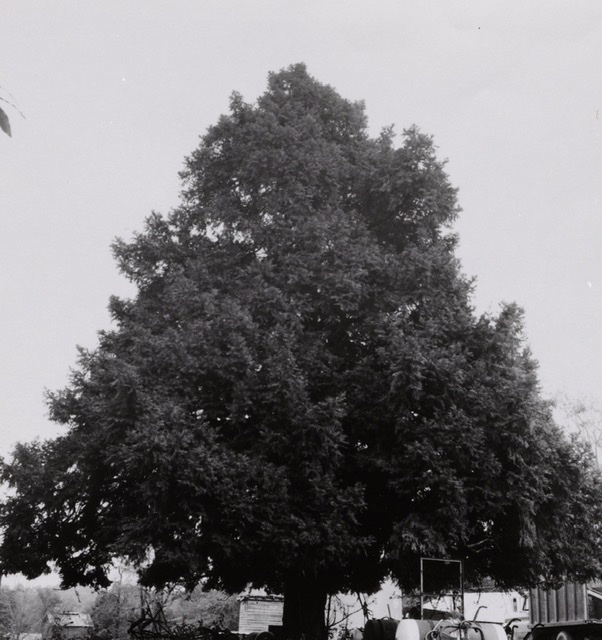
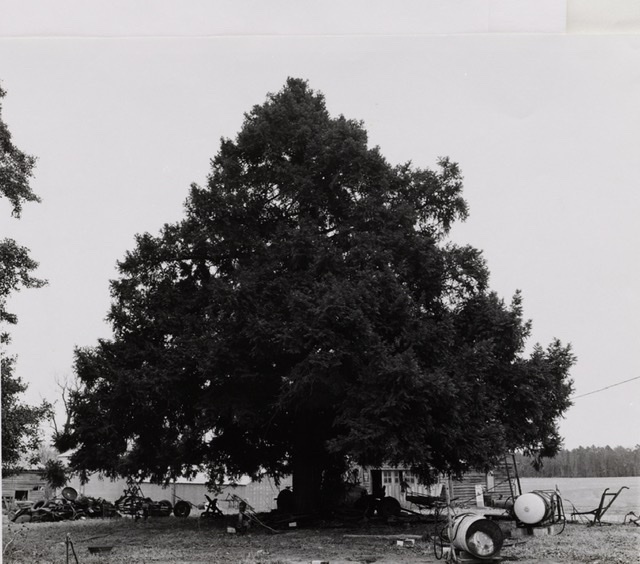
"I got these images from a herbarium sheet that showed F.G. Meyer as the collector. It was nice to see pictures of the tree in its healthier years.... Clay Nolen was the photographer of those photos."
__________

LEE BARNES, email to Jeff Morris of 30 July 2007:
"Bill Alexander at Biltmore Gardens knows of the tree; his wife was a roommate with a woman who was "related" to the tree, possibly a daughter of the landowner. He can give you more info. As I remember, the tree was given to a NC Senator, but I cannot remember details of over twenty years ago!
"I remember the tree had numerous basal sprouts (many dozens in a clump) that would make good cutting material. I recommend dormant cuttings after a few hard frosts in the fall. Good luck on the hunt for cuttings.
JEFF MORRIS, email reply to Lee Barnes of 30 July 2007:
__________
"Briefly, the Norlina site is in Granville County, near the Virginia line. I spent a whole day there, and scoured the town in search of a Torreya taxifolia. I even contacted the Agricultural Extension agent, and he knows of no such tree in or around Norlina. I would like to think the legend is true, but I tend to think that if there were once a T. taxifolia, it has either been forgotten or removed by newer homeowners."
 __________
__________
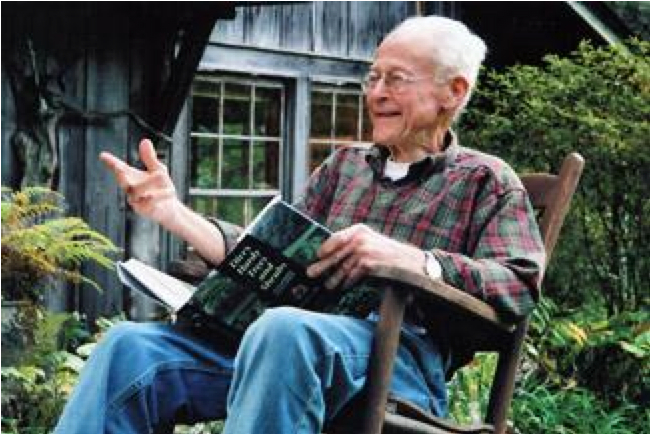
"You probably know that the largest recorded Florida Torreya is located on a farm near Norlina, NC, listed in the current register of big trees with a huge stem diameter of nearly three and a half feet, but only 53 feet tall.
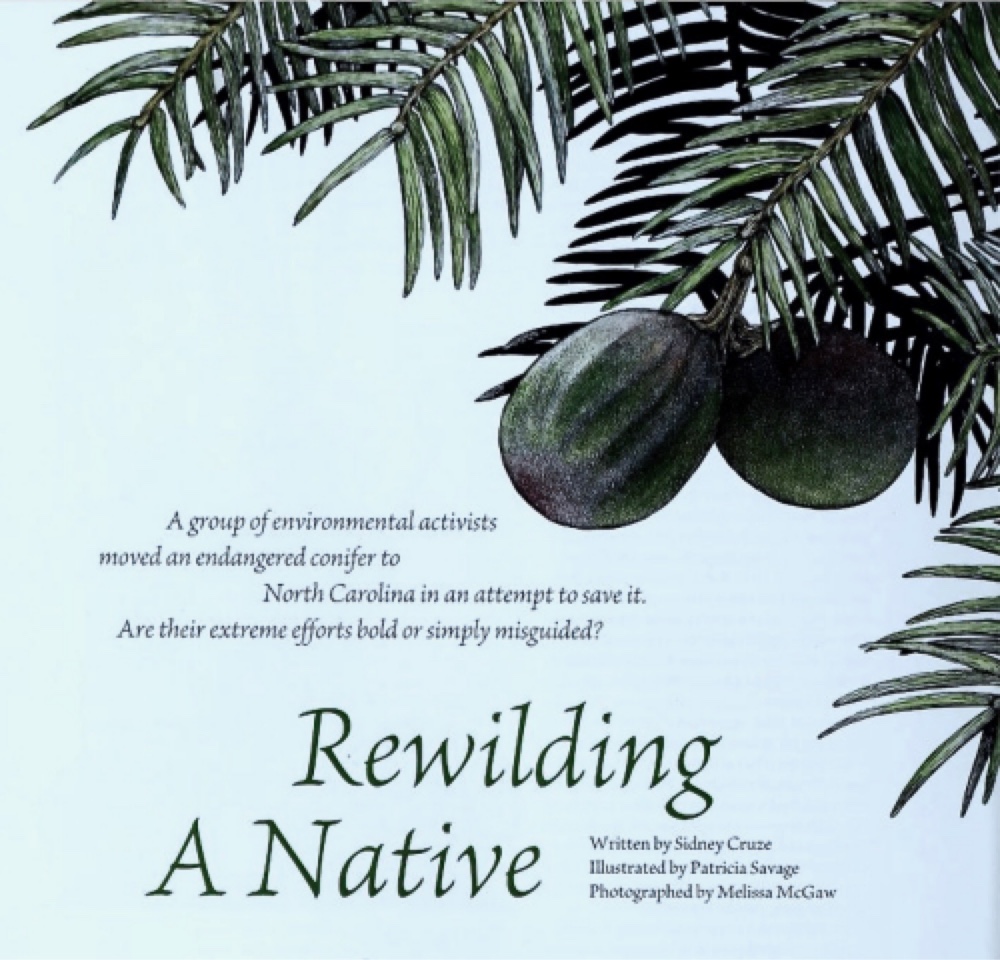
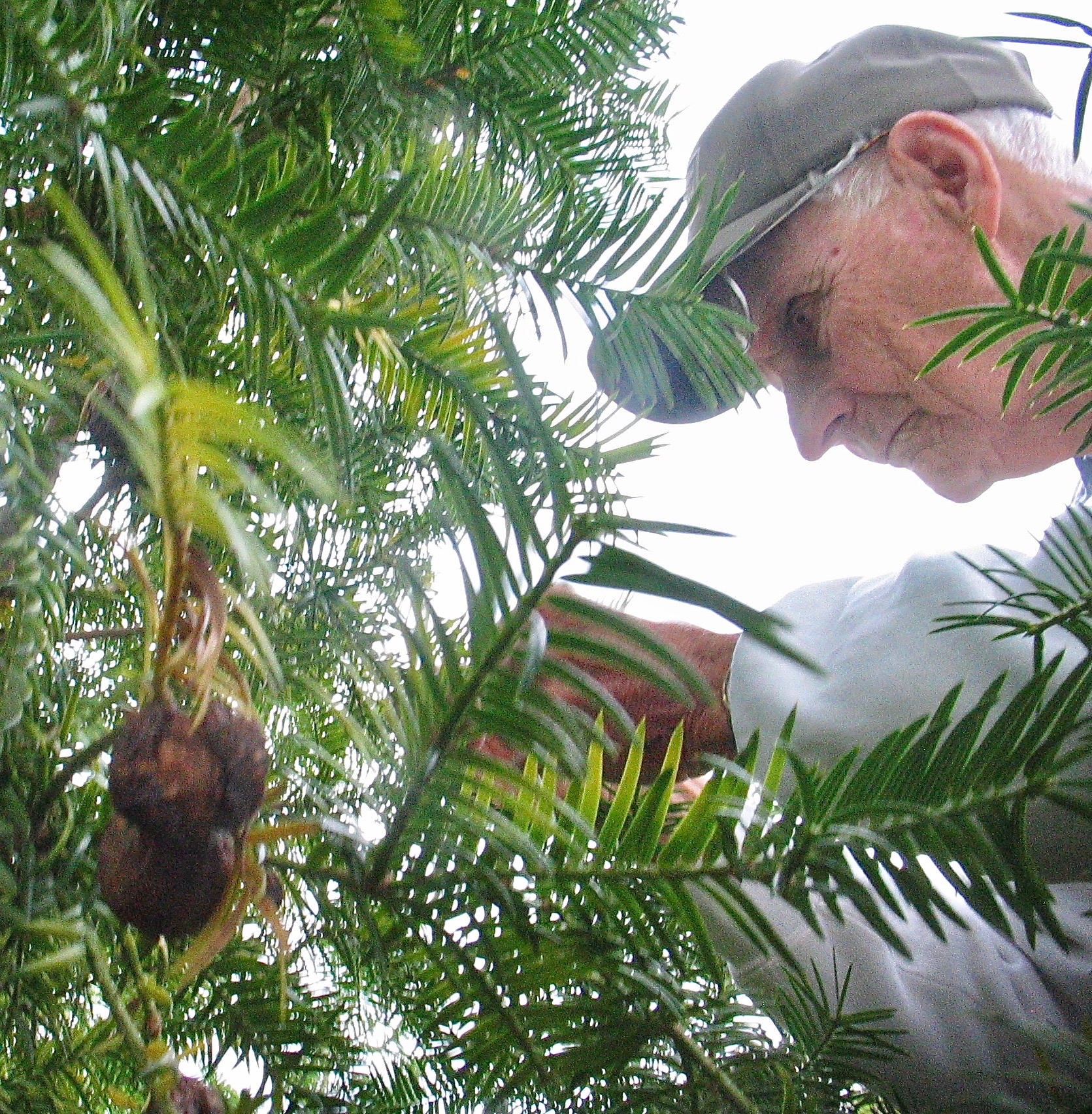
A. J. BULLARD (1939-2020) spoke to the Editor of North Carolina Wildlife, reporting on the Florida Torreya he has gathered seeds from in Clinton NC.
"Mount Olive botanist A. J. Bullard called to inform us that some information was missing from our story "Rewilding a Native" by Sidney Cruze in the Aug 2009 issue. When we asked what was missing, Bullard blew our minds by revealing that there is another living Torreya taxifolia tree in North Carolina that is well over a century old.
__________
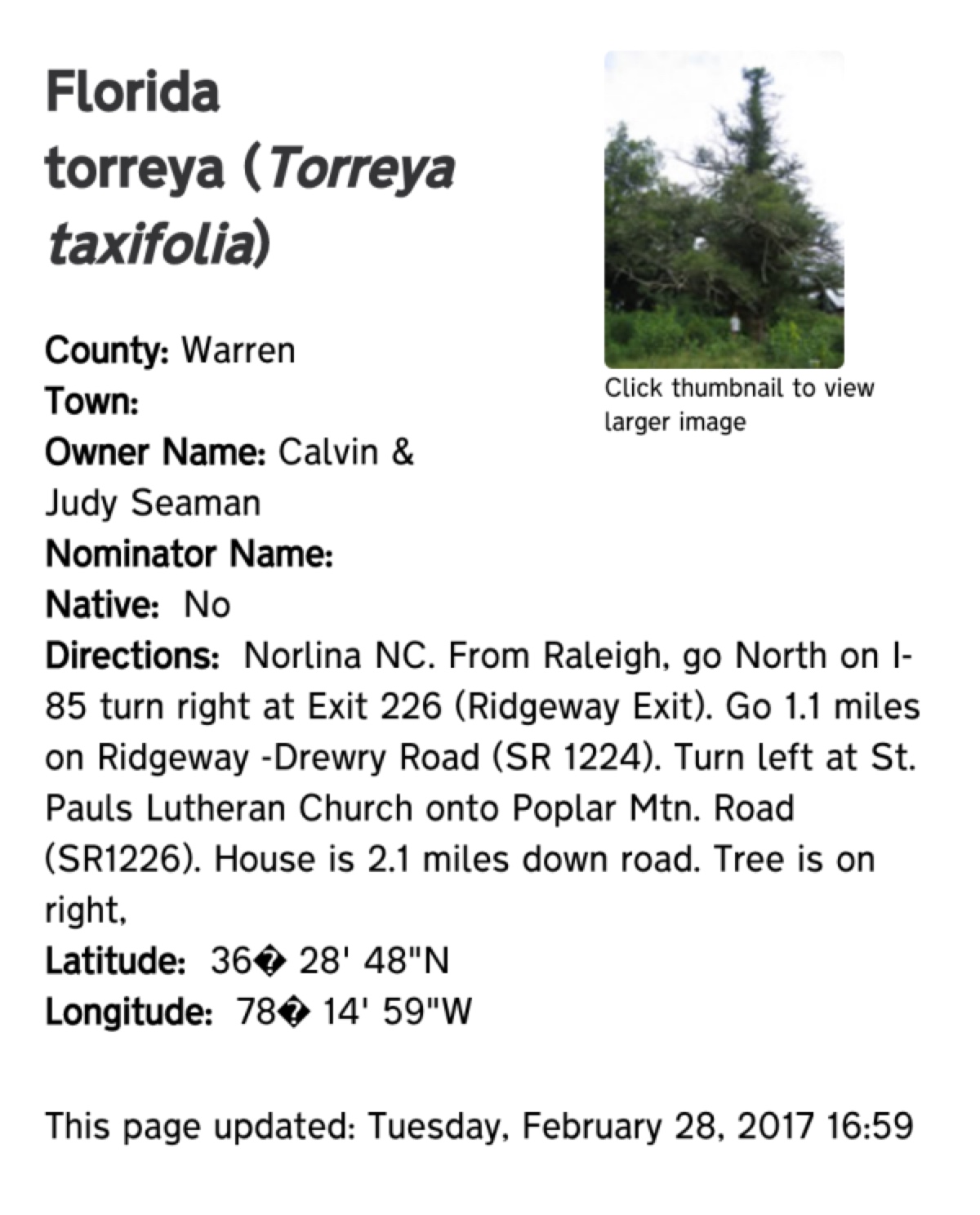
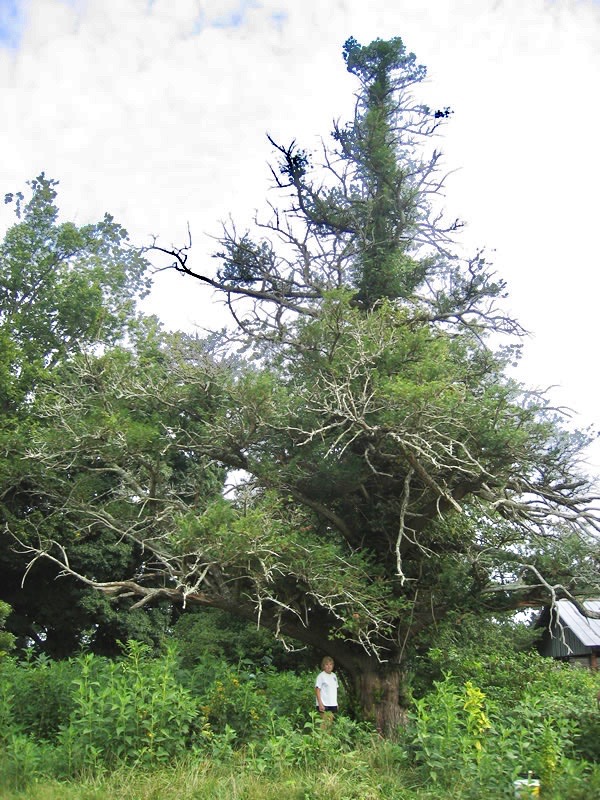
Note by CONNIE BARLOW:
As of 2021, there is no champion listed because Florida Torreya now appears on the "ineligible" species list. The notation for its removal from the eligible list reads:
"Not listed in Flora of the Southeastern United States: North Carolina, October 20, 2020 edition, as naturalized in North Carolina."

Yet, notice that the above 2020 edition not only mentions the Torreya grove at Highlands, NC, but also that "young saplings are established downslope and beneath" the grove. Torreya Guardians has documented full naturalization at the Highlands grove: Harbison House. So the removal of the species from eligibility in the North Carolina champion list is not justified. Instead, consider the three photos below of big specimen trees (each of which has established seedlings/saplings nearby). Any of them could support the return of a champion listing for Torreya taxifolia in North Carolina:

Photo by Connie Barlow, 2015
Photo by Connie Barlow, 2015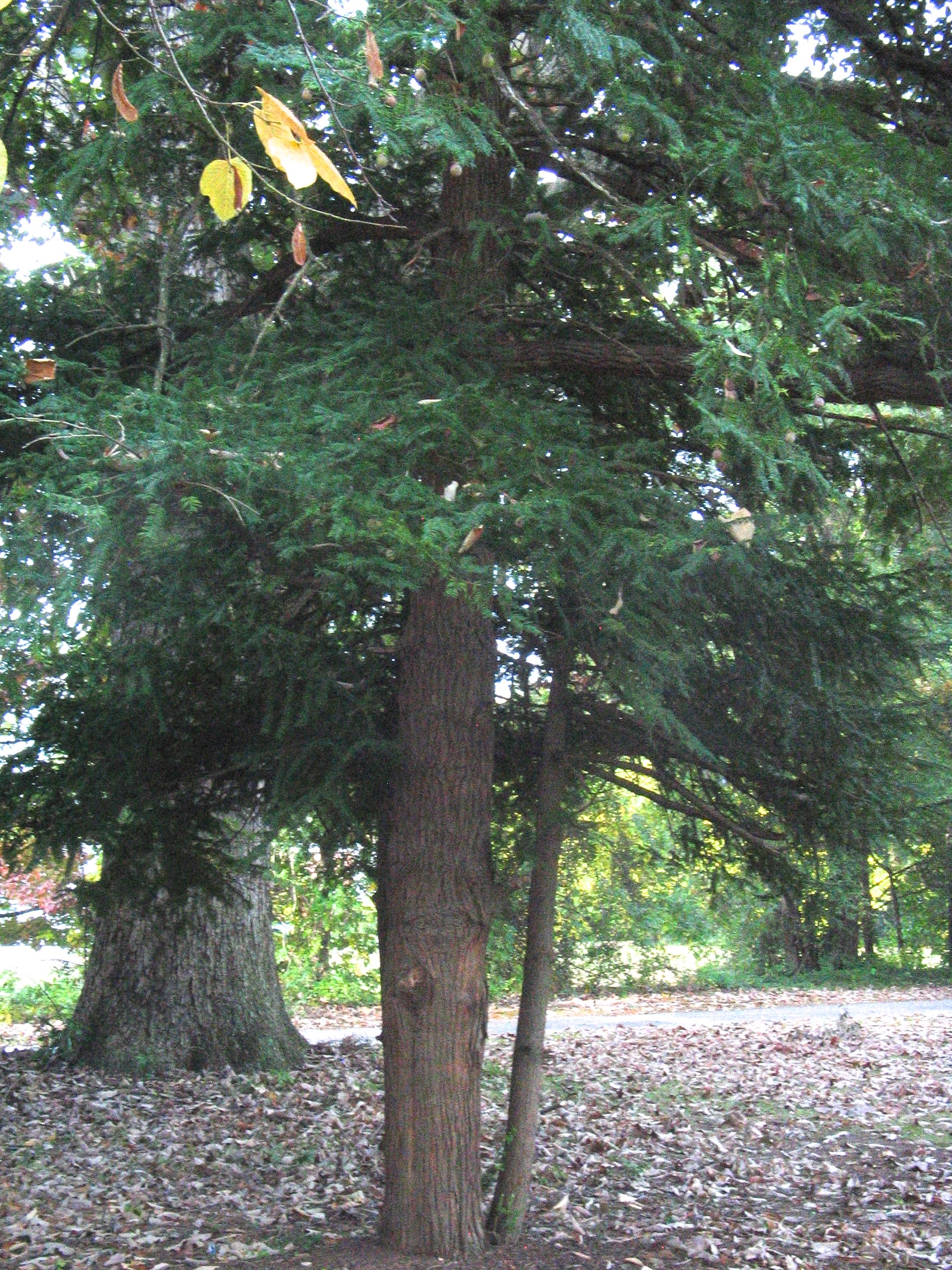
Photo by Connie Barlow, 2013
I recall that the Norlina Tree used to also be listed on the American Forests Champion Trees site, and then a few years ago the champion switched to a Florida Torreya in a cemetery near Cincinnati — which, though huge and healthy, is not a tree but a shrubby clone that developed from a rooted branchlet planted long ago. Now, in 2021, I checked again and Florida Torreya is no longer listed as a tree species having a "champion."
Resurrection of the Old Norlina Tree
by Paul Camire, 2021
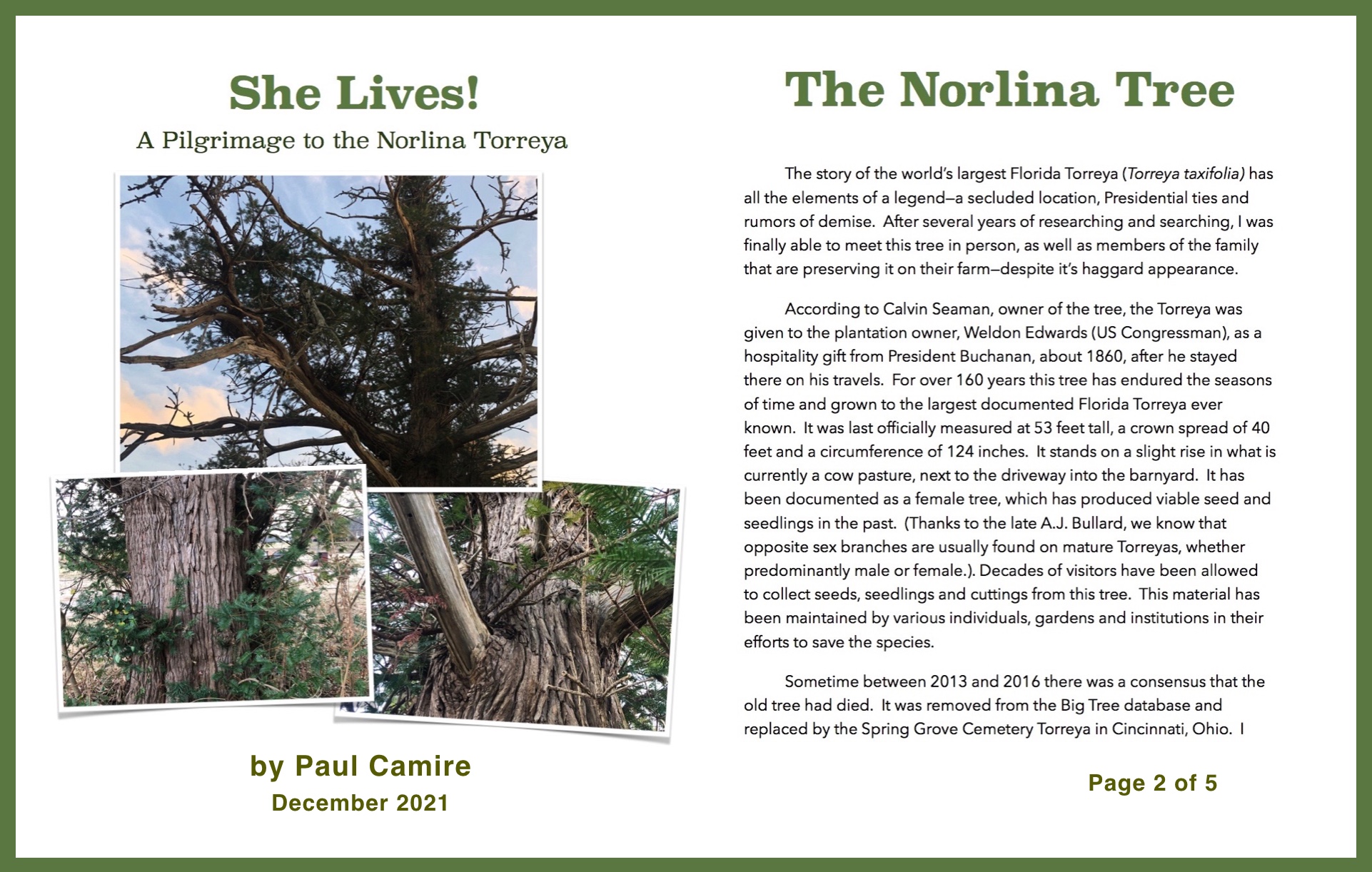
December 2021
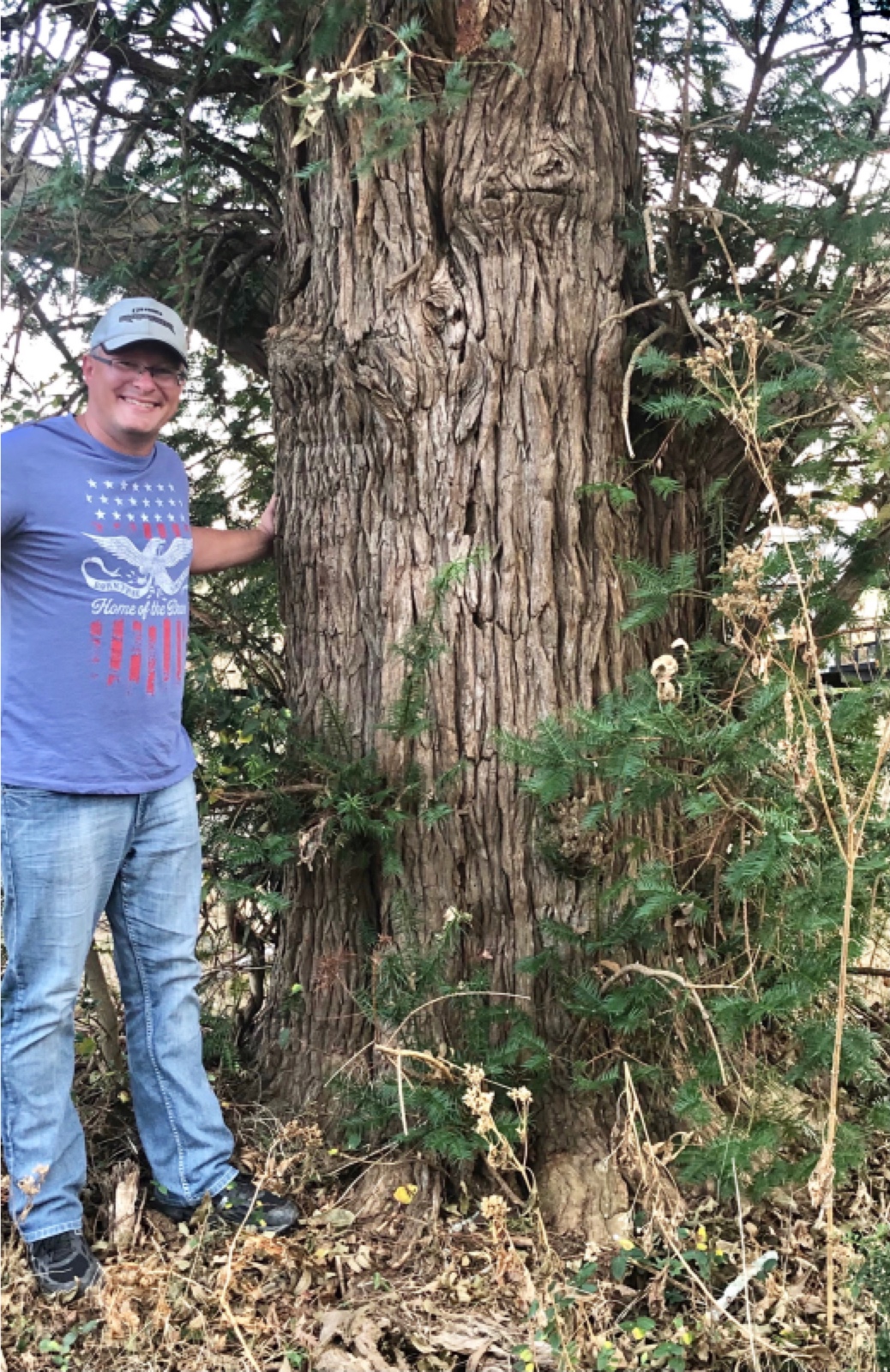
Here is how Paul first recounted his adventure in an email:
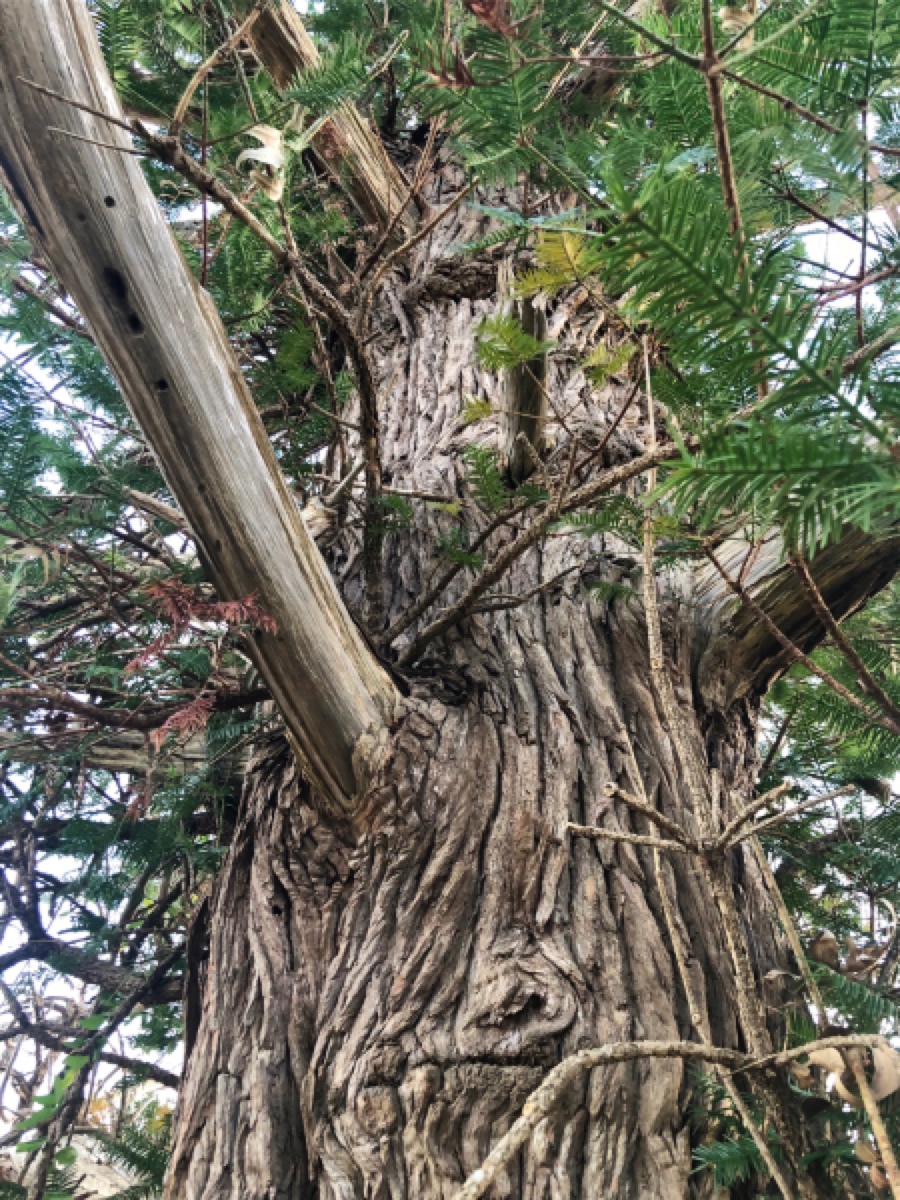
As I was pulling up to the farm, I could see the tree was alive and someone was in the garage unloading groceries. I inquired if I could photograph and take a look at the Torreya and I was told, by their daughter, to go ahead, but to shut the wire behind me so the cows didn't get out.
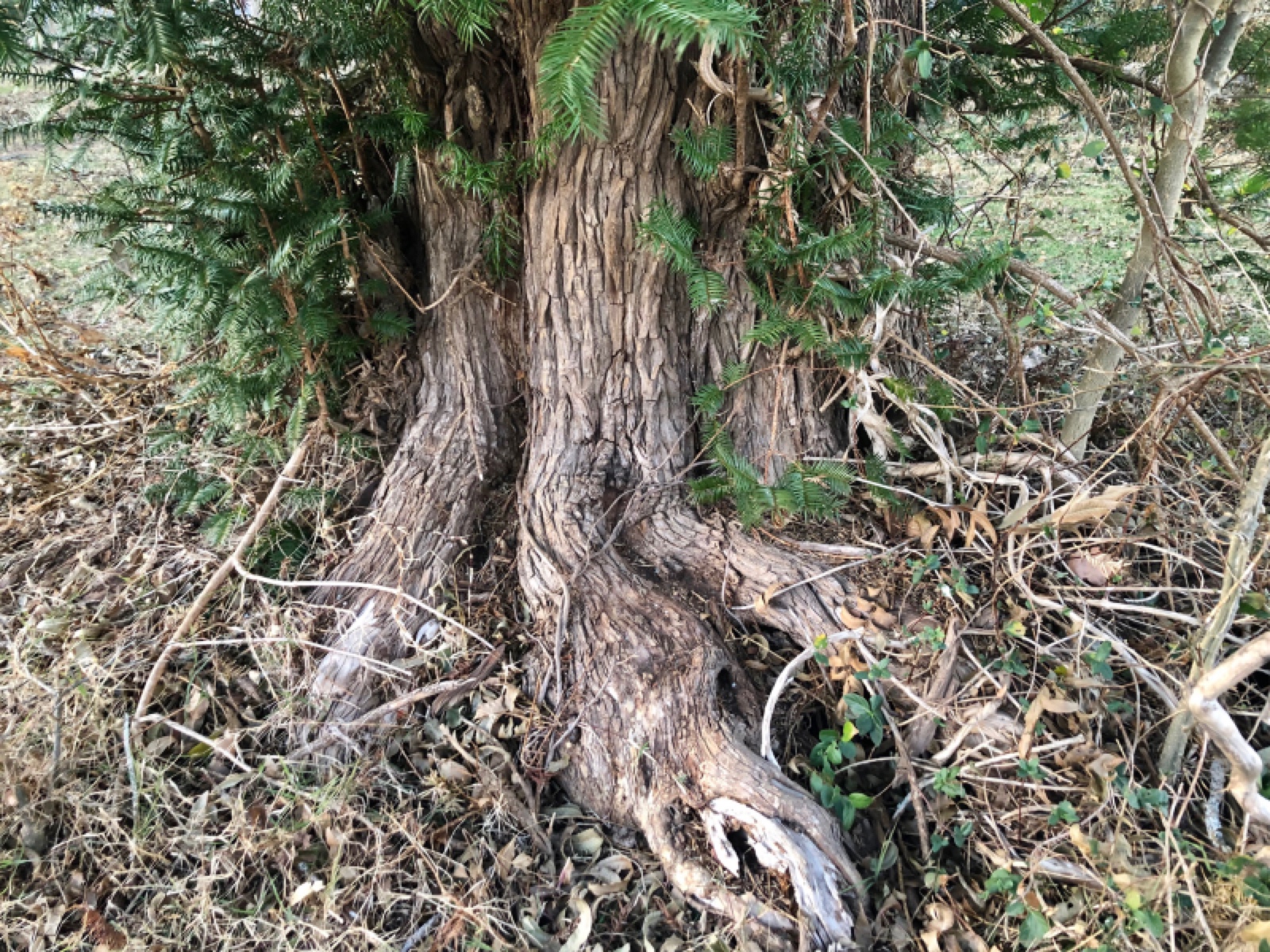
I actually found an old article that repeats this information.
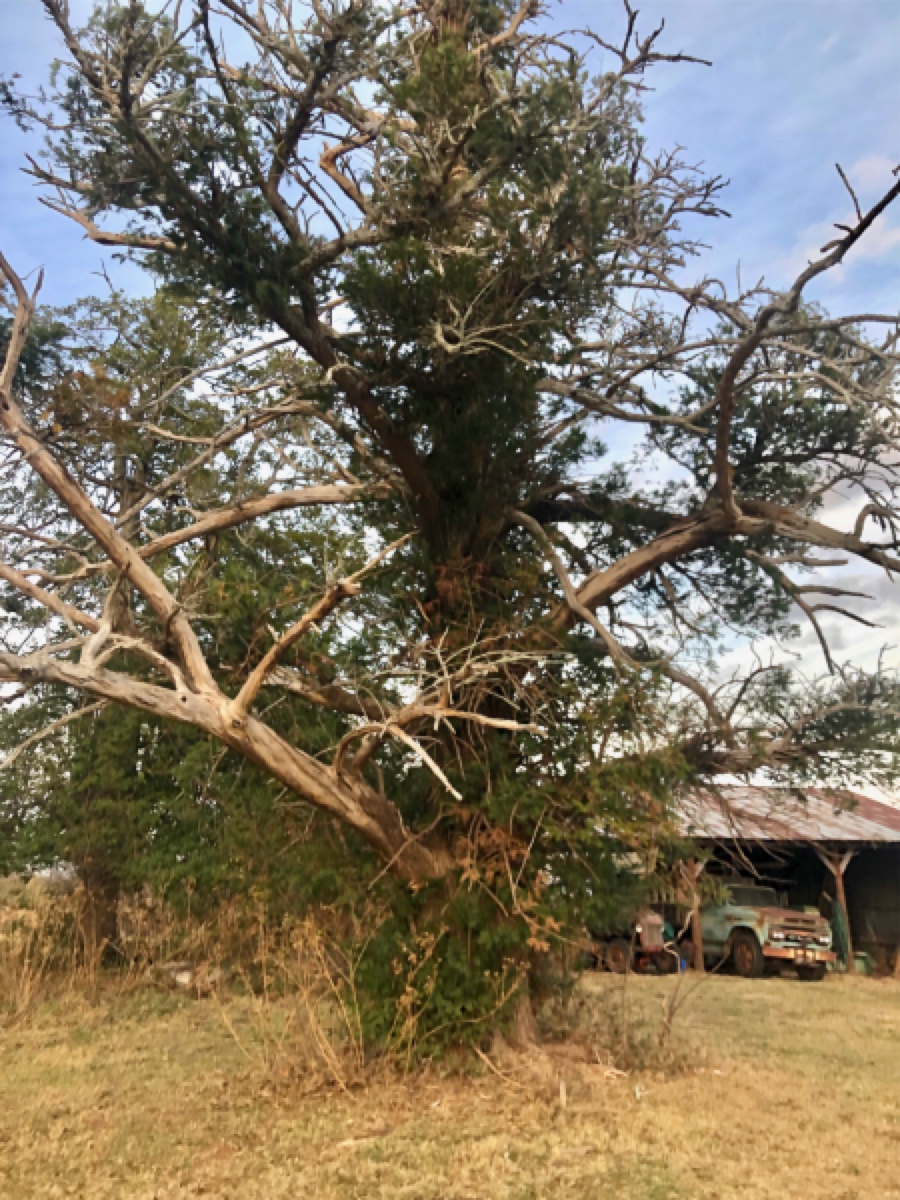
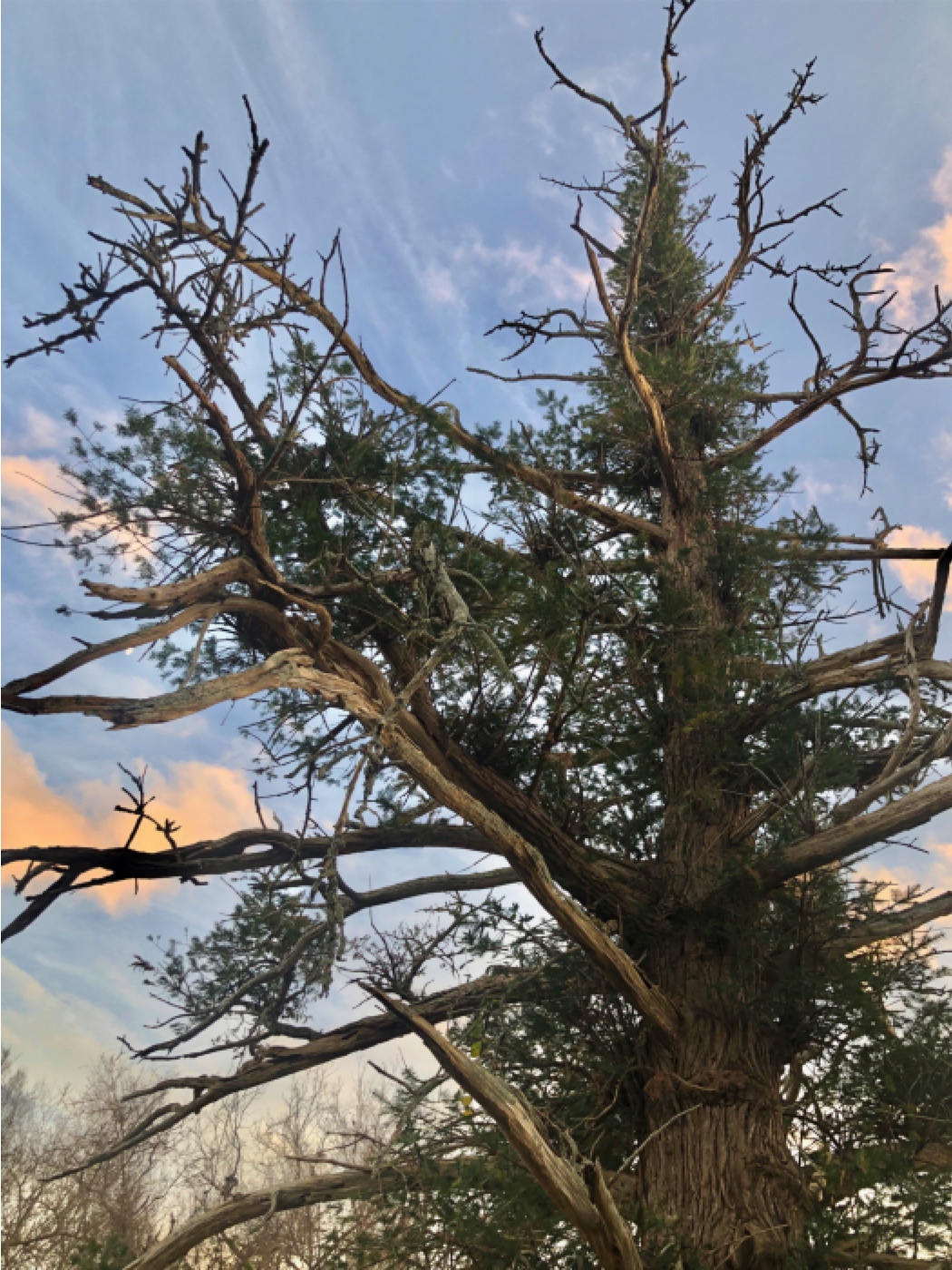
of the
Near-Death
Experience
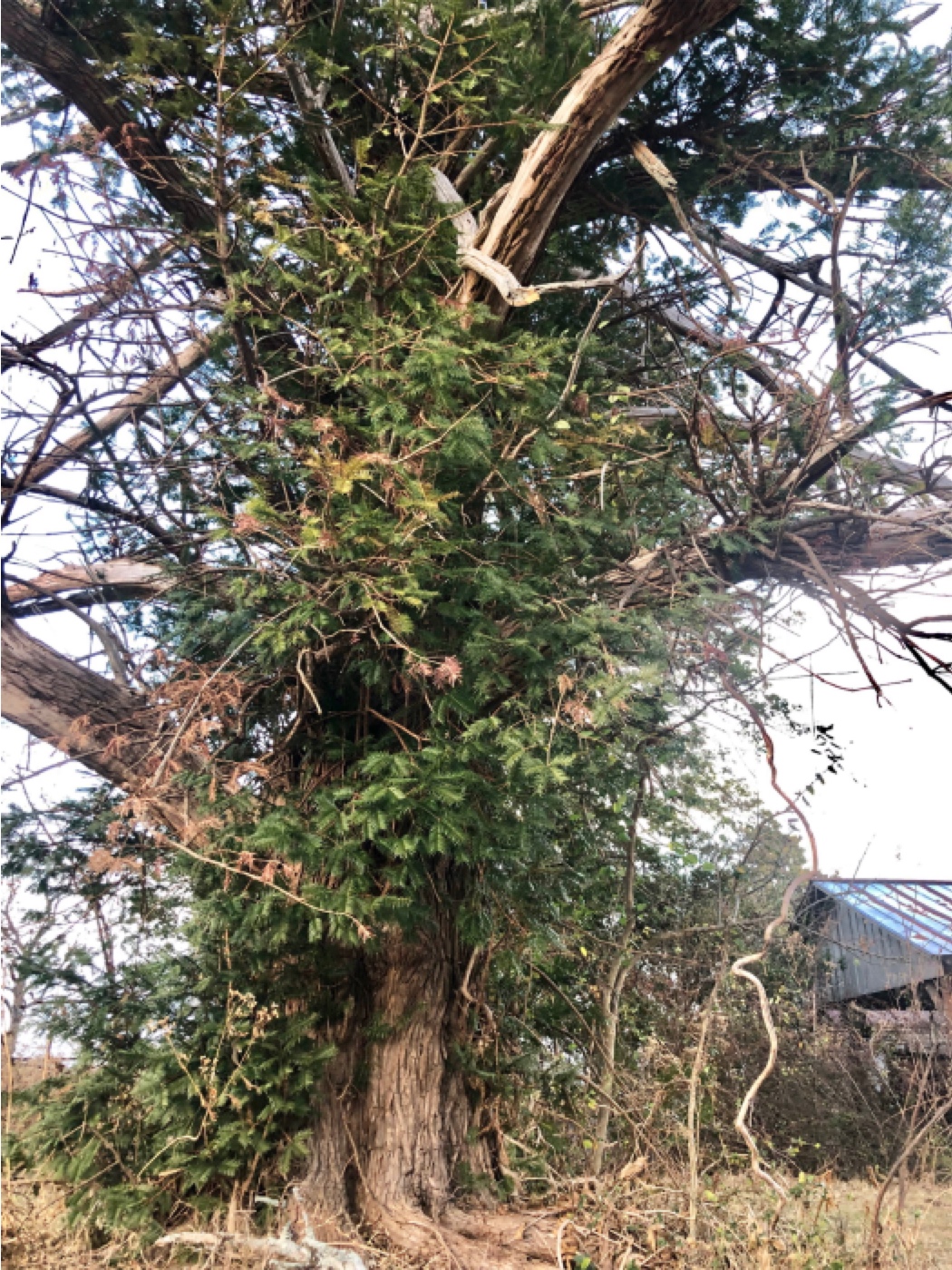
Calvin believes that some of his farming herbicides must have spilt and got picked up by the tree.
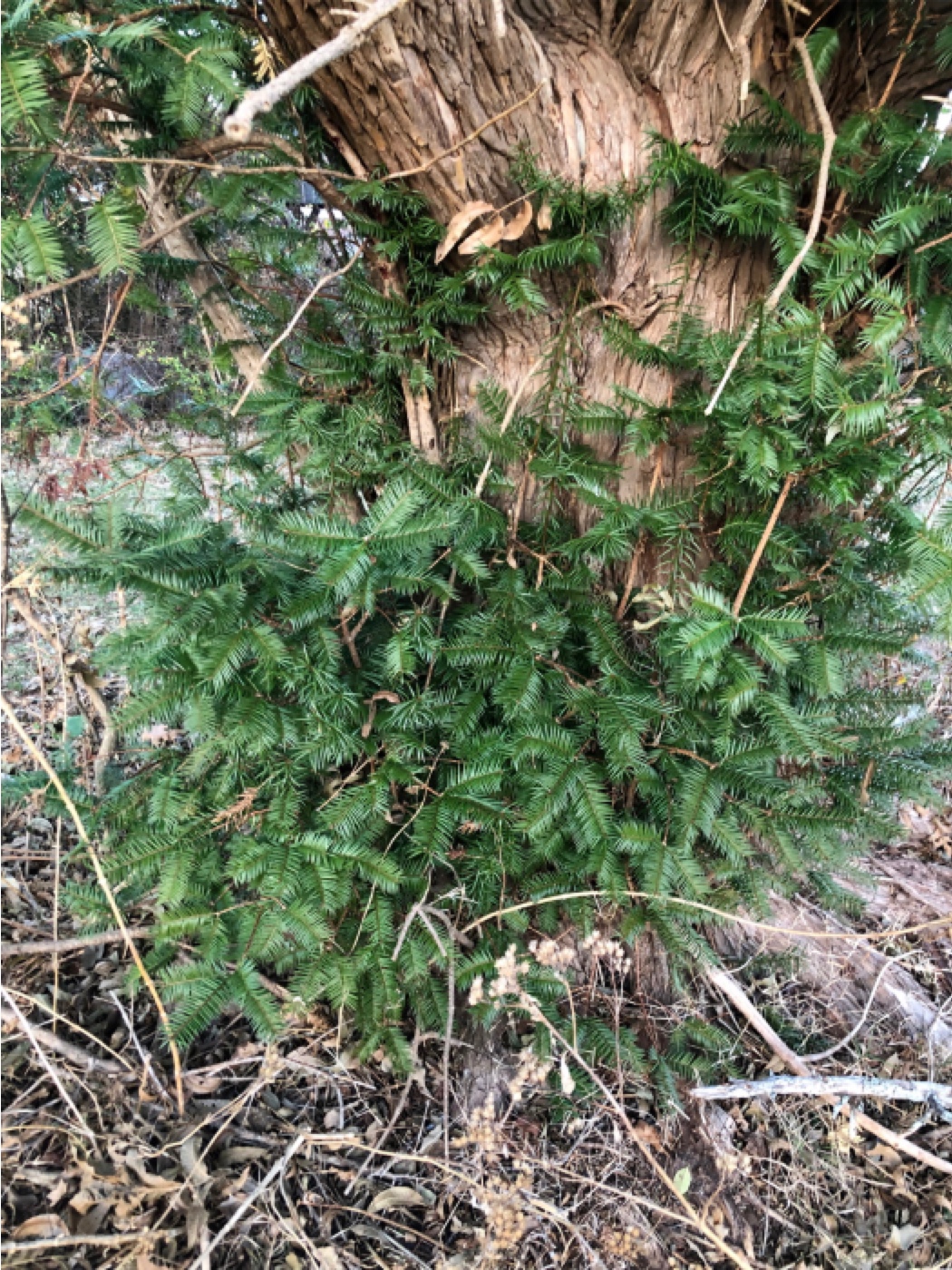
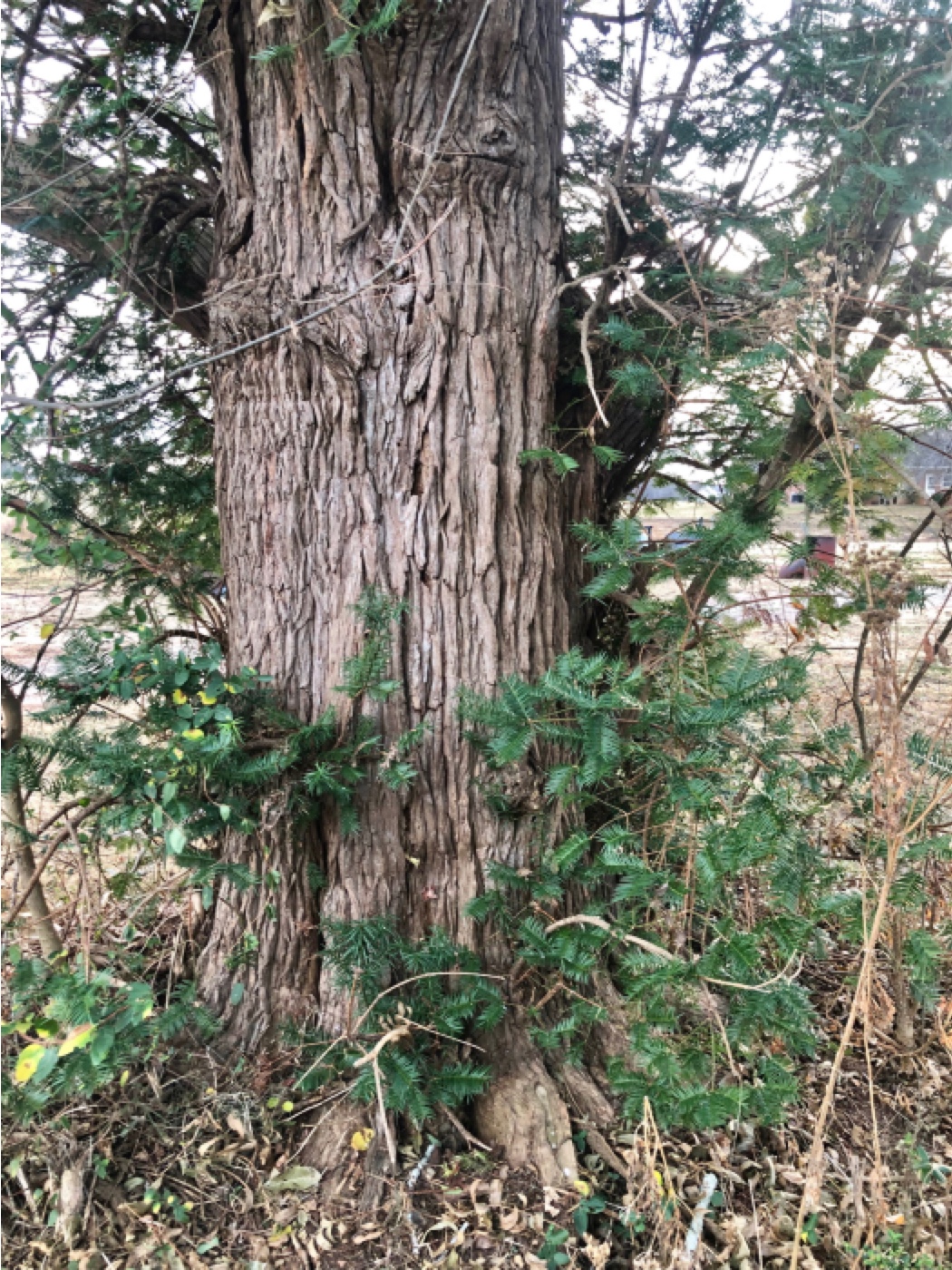
Basal sprouts emerge from 2/3 of the circumference of the trunk.
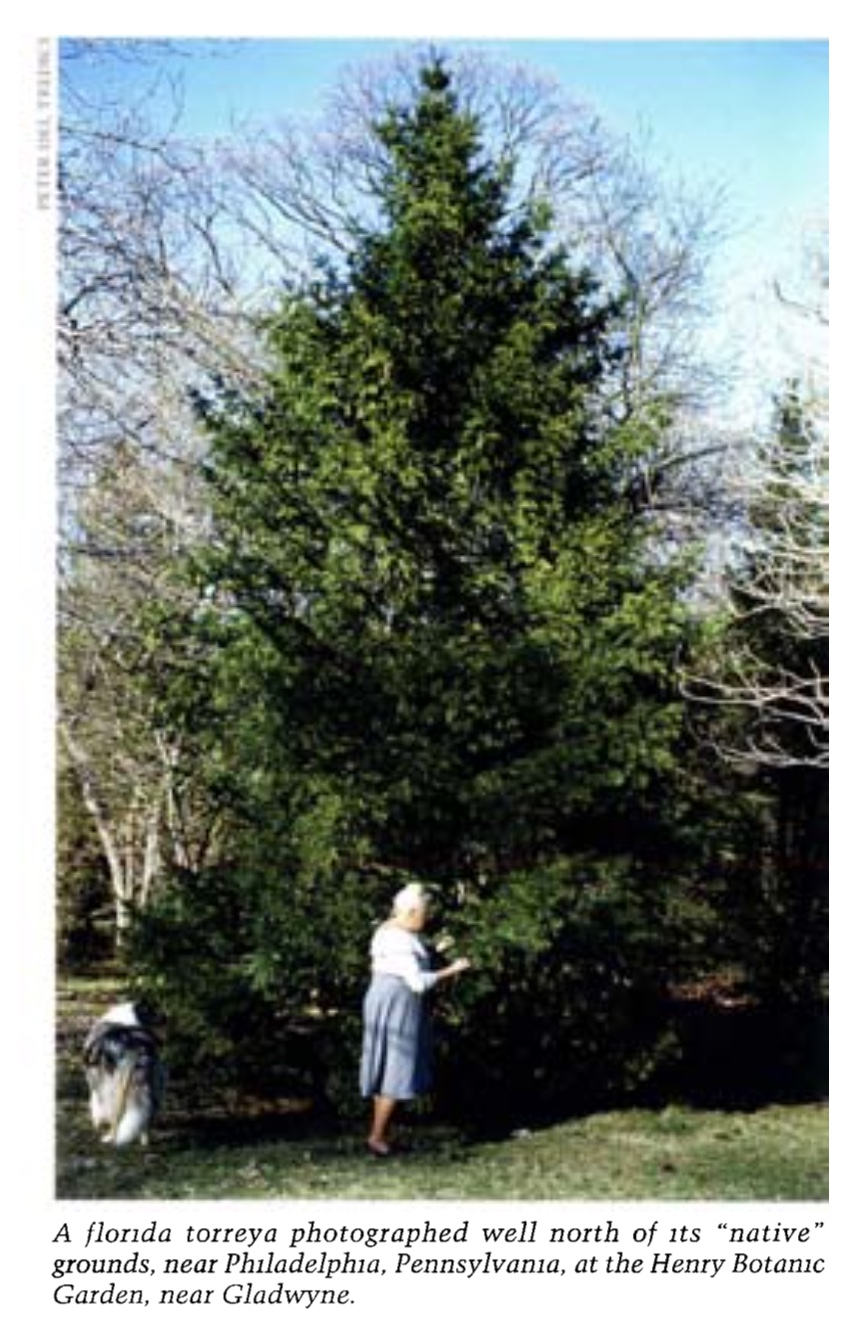
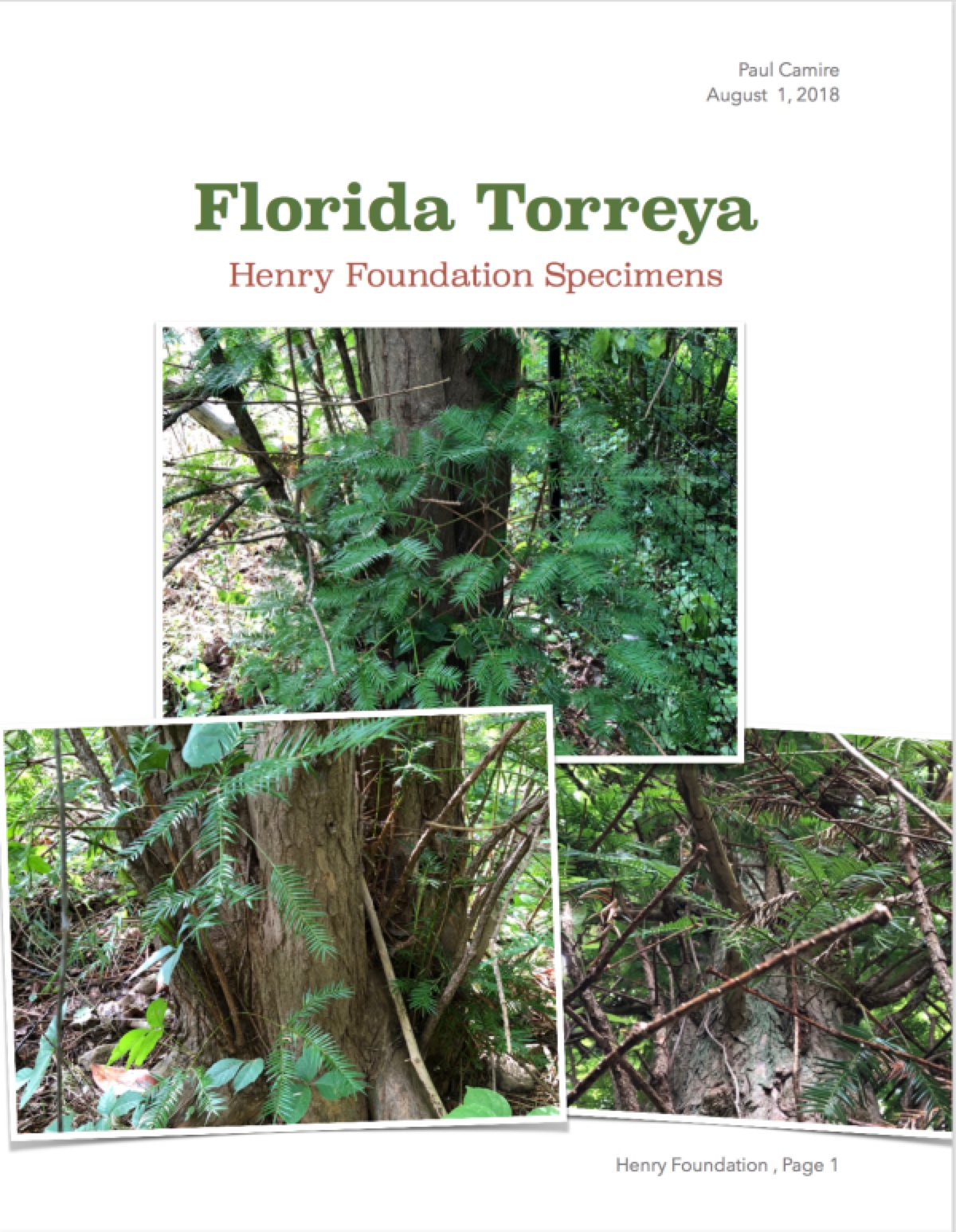
Decades ago, while the Norlina Tree was still very healthy, Woodlanders Nursery in Aiken, South Carolina, procured a number of its seeds and some cuttings, which the nursery then rooted.
__________

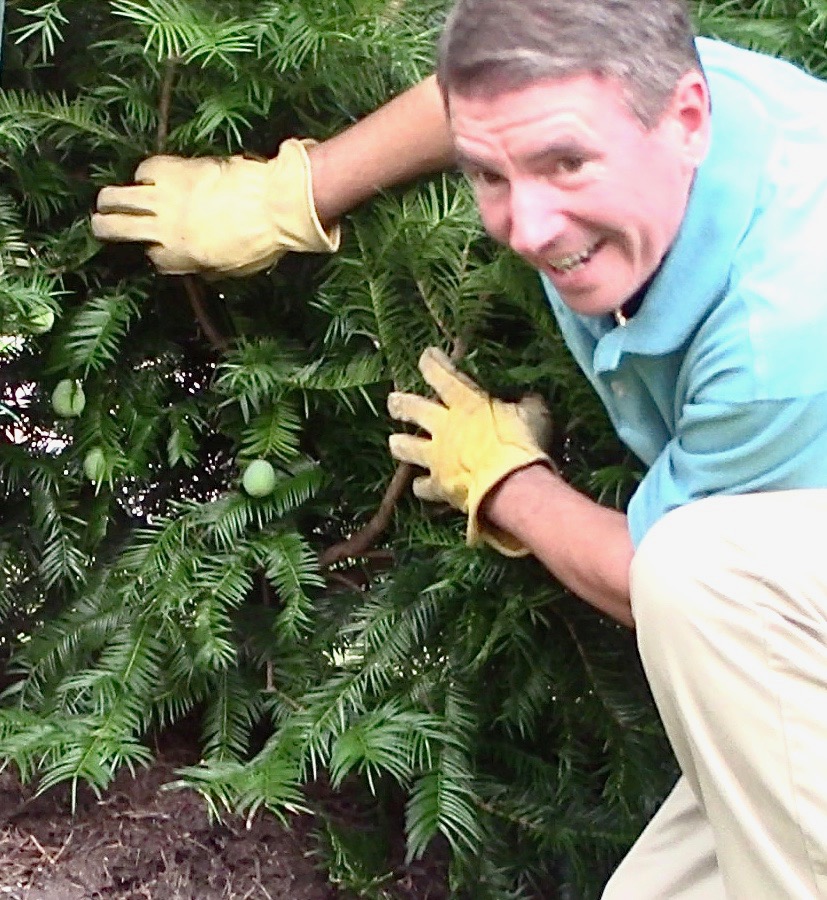
__________
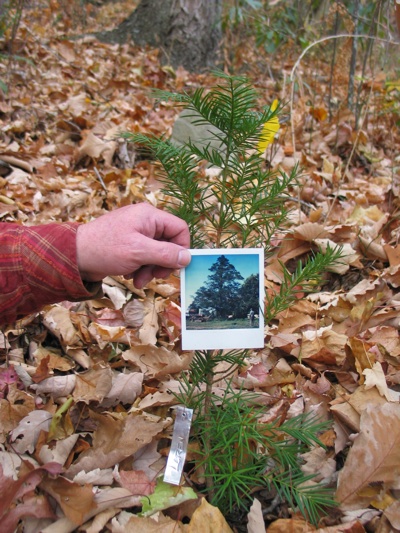
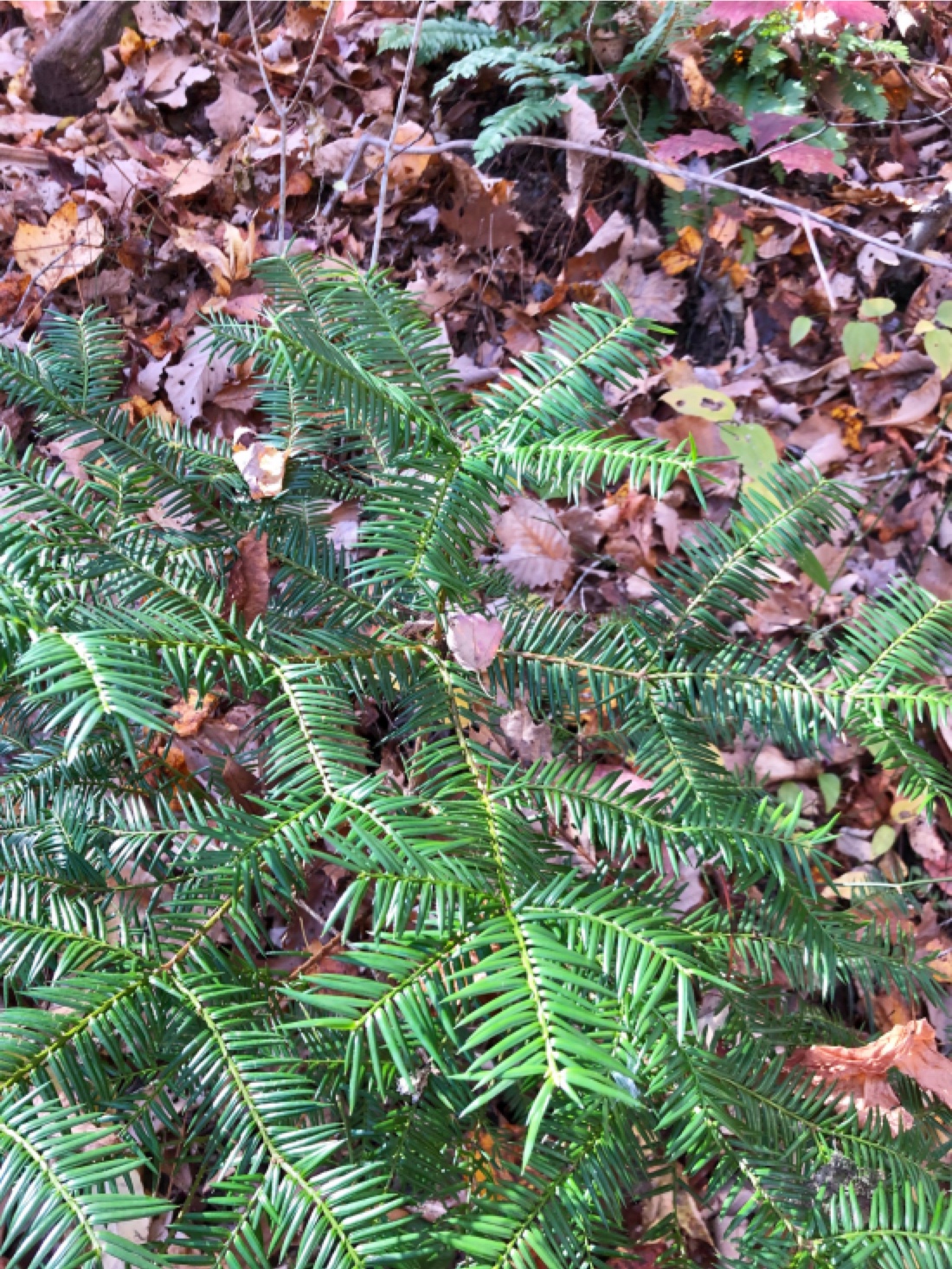
In 2008, Torreya Guardians purchased 20 potted seedlings from Woodlanders (and thus grandchildren of the Norlina and Gladwyne trees) and planted them in the steep, mountain-side forest of a rural home west of Waynesville, NC. Waynesville resident Lee Barnes, a founding Torreya Guardian, coordinated the effort.
